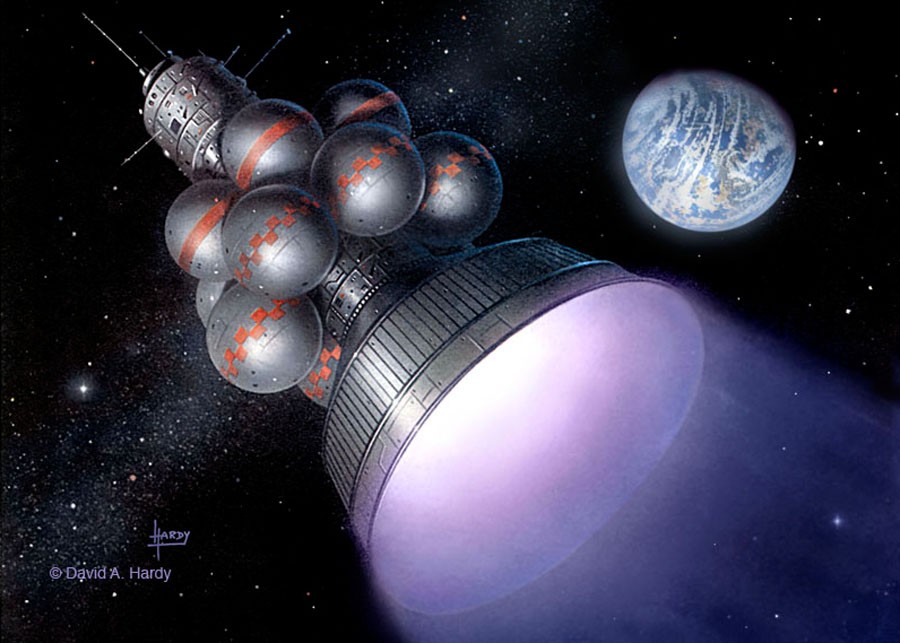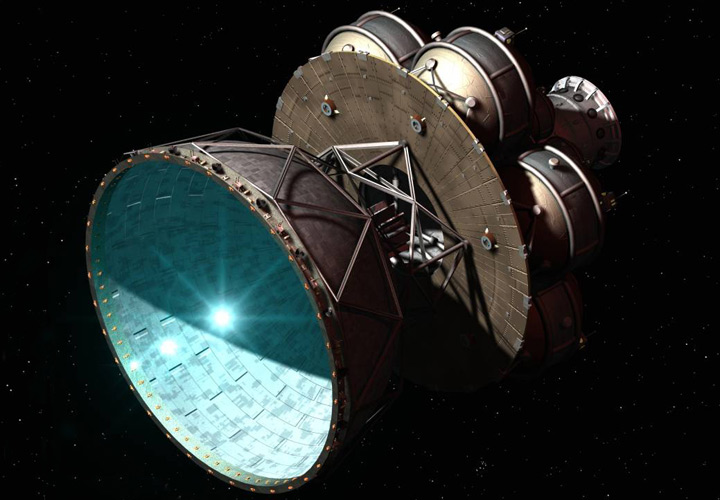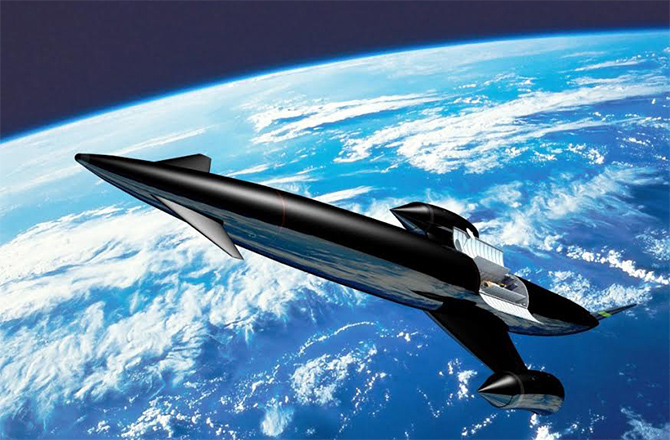Project "Daedalus": automatic spaceship hails from the 70s of the last century

So far, one can only dream of flying to the stars. To fly to any of the neighboring stars on a starship for any sane time (say, human longevity) is a difficult task. Sending starships with a large number of colonists in the hope that the fifth or tenth generation will reach the goal is also impractical. In the end, it is unknown what will be waiting for the colonists in a foreign star. Maybe there will only be gas giants or planets unfit for settlement.
Projects of interstellar ships so far look too complicated to implement in our time. Even the relatively simple Breakthrough Starshot project (simple compared to other interstellar space projects) can only be realized if modern technologies are improved. On the other hand, interstellar flights no longer seem incredible. In many ways, we owe this technical project to the automatic spaceship Daedalus. Its authors, instead of inventing the concepts of flights on a hyperdrive, decided to approach the matter as practical as possible, based on existing technologies or technologies of the near future. The project was developed in the 70s of the last century.
Specialists of the British Interplanetary Society worked on the design of the Daedalus. They initially rejected the idea of creating a manned spacecraft, deciding to create an automatic probe. Initially, the device was conceived as a scientific drone, which was supposed to reach the star Barnard in 50 years. The ship was designed in such a way that it could be sent not only to the star Barnard, but also to any other star in the observable Universe.
')
According to scientists, it is necessary to construct the “Daedalus” in the Earth’s orbit. The planned mass of the ship is 54,000 tons, including 50,000 tons of fuel and 500 tons of payload (mainly scientific instruments). According to the developers, "Daedalus" should consist of two stages. The first stage is designed exclusively for acceleration of the starship to 7.1% of the speed of light.
As soon as the ship reaches this speed, the first stage is undocked, after which the second stage engine turns on, increasing the ship’s speed to 12% light. According to the designers, the ship would have to accelerate to a given speed of about 4 years. Due to the extreme working conditions, a number of engine elements were planned to be made from an alloy of molybdenum with titanium, carbon and zirconium. Such an alloy retains its properties even at ultra-low temperatures.
When designing a spaceship scientists have considered several options for engines. Among other options, an electric rocket engine with a nuclear reactor and a controlled thermonuclear fusion engine were considered. They were excluded due to the allegedly low thrust and heavy weight. To achieve the desired speed of 7.1% with such engines, Daedalus would have to spend hundreds of years.
A thermal nuclear missile was also considered as one of the options, but in this case it would have to spend a huge amount of fuel. Even then, scientists studied the possibility of using a photon engine with a 3 x 10 9 watts per 1 kg mass of a starship. There would have to create a huge mirror with a perfect mirror surface. In the 70s of the last century, this was impossible (and even now it is hardly feasible in practice), so this option was also abandoned.
The Bassard ramjet engine didn’t fit either, since its work requires a relatively high density of matter in space, and density in interstellar space is insufficient (1 atom / cm 3 ). The disadvantages of the Bassard engine are also the large diameter of the funnel and the high power of the electric field to ensure the normal functioning of the engine. As a result, experts have chosen a pulsed thermonuclear rocket engine . This engine uses pellets with a mixture of deuterium and helium-3.
A fuel pellet with thermonuclear fuel is fed into the spherical chamber of the reactor - a complex construction of a mixture of frozen fuel components in a shell with a diameter of several millimeters. On the outer part of the chamber there are powerful - about hundreds of terawatts - lasers, whose nanosecond radiation pulse through the optically transparent windows in the chamber walls hits the fuel pellet. At the same time, a zone with a temperature of more than 100 million degrees with a pressure of millions of atmospheres is created on the surface of the fuel pellet - conditions sufficient to initiate a thermonuclear reaction. A thermonuclear microexplosion with a capacity of several hundred kilograms in TNT occurs.
The frequency of such explosions in the chamber in the project "Daedalus" - about 250 per second, which required the supply of fuel targets at a speed of more than 10 km / s using an electromagnetic gun. The reaction in this case is as follows: 2H + 3He = 4He + p. with an energy output of 18.3 MeV. The advantages of this reaction are that about 5% of the power is released in the form of neutrons (and in the case of a deuterium + tritium mixture in the form of neutrons, up to 80% of the power is released), another 20% is released as x-rays. All other energy can be used to create thrust.

Helium-3 is impossible to produce in the right quantities on Earth, here it practically does not occur. Therefore, scientists decided to mine it either in the atmosphere of Jupiter (which is not very realistic in any foreseeable future) or on the Moon, which is more real.
The second step of the Daedalus is a complex and perfect spacecraft. Its design includes a 5-meter optical telescope and two 20-meter radio telescopes. With the help of these tools, it was planned to study the neighborhoods of the Barnard star. The obtained data was planned to be sent to Earth using a 40-meter nozzle of the second-stage engine as an antenna.
Since the braking of the ship is not provided, for an additional study of the vicinity of the Barnard star, experts suggested using autonomous probes of a smaller size. A few years before arriving at the target, the probes had to undock from the Daedalus and fly to the star Barnard on their own. Each probe was to be equipped with cameras, spectrometers and other scientific equipment. The speed of the probes is 12% light. Each of them must have its own nuclear-ion engine.
To protect the ship and its elements from collisions with interstellar particles, the authors of the project proposed to install a beryllium shield. The thickness of the disc should be 7 mm, the mass of the disc in this case will reach 50 tons. Upon detection of larger objects with which the shield could not cope, the ship should emit clouds of particles that would go up to 200 km from the ship. To repair the damage on board, Daedalus was offered to load a team of mechanical repairmen who would solve the most complex problems.

Specs
- Ship length: 190 meters
- Payload mass: 450 tons
- First stage mass without fuel: 1,690 tons
- Second stage mass without fuel: 980 tons
- Mass of the first stage fuel: 46000 tons
- Second stage fuel mass: 4000 tons
- The duration of the first-stage engines: 2.05 years
- Duration of the second stage engines: 1.76 years
- Thrust engines first stage: 7540000 newton
- Traction engines second stage: 663000 Newton
In general, the "Daedalus" - the first draft of a starship, which was carefully developed by scientists. It provides many situations that may arise during the flight. Of course, there are problems. The main one is the complexity of the implementation of a number of technologies that are proposed to be used in the design of the ship. This is a pulsed thermonuclear rocket engine, and a shield of beryllium, and helium-3. Unfortunately, such a ship cannot be built yet, even if all of humanity takes up its implementation. The advantage of the project is that it showed the potential for flying to the stars, transferring interstellar flights from the category of fiction to the category of technologies of a not-so-distant future.
Daedalus has a related project, Ikar, which I would like to talk about in more detail.
Project "Icarus"

The authors of "Icarus" say that "Daedalus" inspired them to develop their own ship. The teams of the British Interplanetary Society and Icarus Interstellar are working on it. The "Icarus" project is an improved and modified in accordance with the evolution of technology and our knowledge of the Daedalus Universe. Members of both teams are scientists, engineers and enthusiasts who hope to develop a real interstellar ship by 2100. Some members of the team "Icarus" previously engaged in the development of "Daedalus".
Such a spaceship, according to the plan, should be able to reach any star that is from the Earth within a radius of 15-22 light years. At a distance of 15 light years from us are located 56 stars. Epsilon Eridan (located at a distance of 10.5 light years from Earth), Gliese 674 (14.8 light years) and Proxima Centauri are the most suitable for studying. As astronomers have found out, the star Barnard does not have a planetary system, therefore there is simply no sense to fly there. At the same time, the spacecraft is planned to be sent to the neighboring star, where a potentially habitable exoplanet was discovered (a recent example is the planet at Proxima Centauri).
Proxima Centauri b (also known as Proxima b) is an exoplanet rotating around the red dwarf Proxima Centauri, the closest star to the Sun. Located at a distance of about 4.22 light years (1.3 parsec, 40 trillion km) from Earth in the constellation Centaurus. It is the closest known exoplanet and at the same time the closest exoplanet located in the habitable zone. This planet was discovered by employees of the European Southern Observatory in early August of this year.
The discovery of several exoplanets in the habitable zone of a number of nearby stars is an essential element of the Icarus project plan. After all, a spaceship will have to build the forces of all mankind. And if such a device, having flown to another star, finds there only a couple of gas giants or does not find planets at all, then this can be considered if not a failure, then not a very positive result of the entire mission. Studying an earth-like planet from another star is a maximum program that will satisfy all project participants.
The difference between the Ikar project and the Daedalus is that the ship will explore the space in detail on the way to the target. Daedalus had to cross the system under study in two or three days. “Icarus”, according to the plan, should stay at the end point for more detailed research. How the delay will be organized is unclear.
"Icarus", as mentioned above, is quite close in its capabilities and characteristics to its predecessor, but it has a number of differences. The main thing is the rejection of "helium-3" as a fuel. Instead, it is proposed to use pure deuterium. Yes, when working with it, a lot of energy will go off as neutrons, but then deuterium is available for human fuel. Available now, and not after 100 years. Neither flights to Jupiter, nor the extraction of "helium-3" on the moon is required. True, if a way is found to obtain the quantities of this element on Earth sufficient for the operation of the ship’s engine, then the former “deuterium – helium-3” scheme can be returned.
The question of conducting a controlled thermonuclear reaction remains open. Now scientists are actively working to create commercially viable thermonuclear reactors on Earth. It is quite possible that with the creation of such a technology and its gradual “refinement”, the development of a fusion reactor for a spacecraft will become a real challenge. Due to the fact that the thermonuclear reactor cannot be significantly reduced yet, the ship will have to be made large. Initially, the authors of "Icarus" wanted to reduce the size of their interstellar spacecraft, but after carrying out a series of calculations, it turned out that it was almost impossible. The smallest spaceship with a thermonuclear engine will weigh tens of thousands of tons.
The “Icarus” will be built on the Earth’s orbit. In order to be able to build such a large ship, a considerable number of smaller transport ships are required. They will supply elements of ship design, people, fuel.

Now there are no suitable transport workers, but there are already ideas on their creation. One of the ideas is being promoted by a group of engineers under the leadership of Alan Bond (this is the engineer who also worked on the Daedalus project). The transport ship, according to the plan, should be small, economical and fast. In addition, it should have a fairly high load capacity. Scientists called such a transport "Cyclops".
The Icarus Interstellar team is also engaged in the development of technologies that in the future will allow us to send manned starships to the stars. All developments in this area are carried out within the framework of the Persephone project . The main task is to create a local ecosystem on the ship that can support the life of pilots during the entire flight time. At the same time, such an ecosystem should change in accordance with the changing needs of the inhabitants of the interstellar manned spacecraft.
To achieve the goals set by the authors, as they themselves believe, the combined efforts of business representatives, officials, scientists and enthusiasts of interstellar flights are required. The participants in the Icarus project say that now is the time when man needs to get out of the solar system and fly to the stars for their colonization.
Source: https://habr.com/ru/post/397217/
All Articles